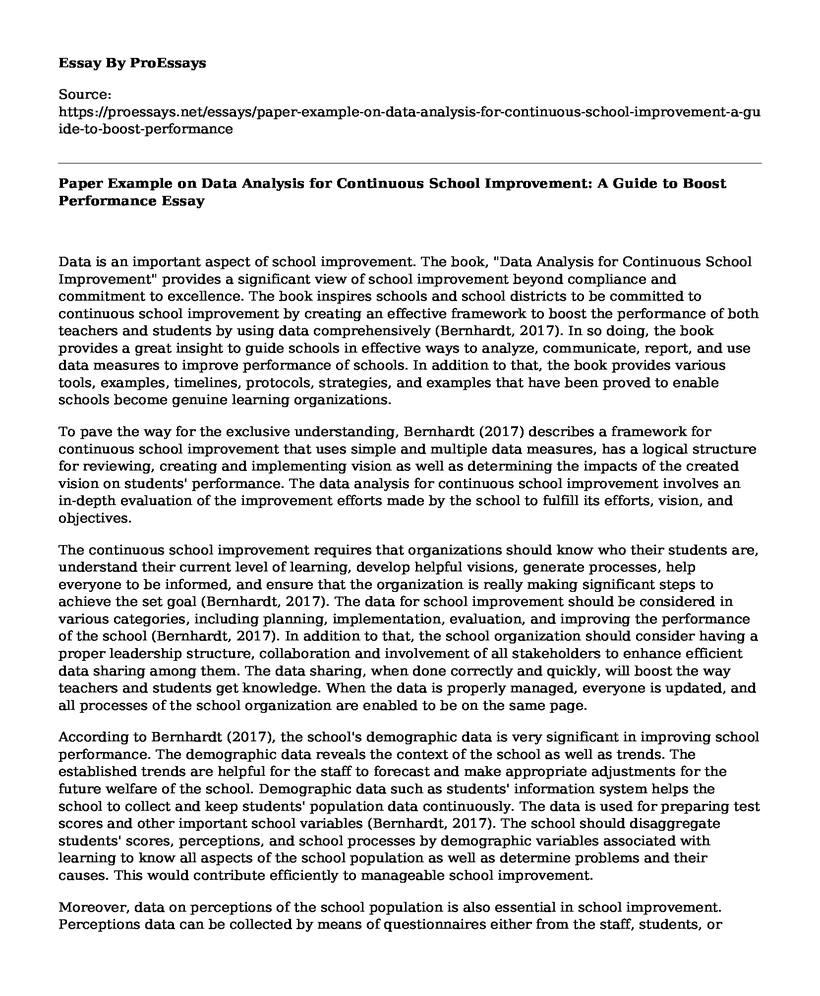Data is an important aspect of school improvement. The book, "Data Analysis for Continuous School Improvement" provides a significant view of school improvement beyond compliance and commitment to excellence. The book inspires schools and school districts to be committed to continuous school improvement by creating an effective framework to boost the performance of both teachers and students by using data comprehensively (Bernhardt, 2017). In so doing, the book provides a great insight to guide schools in effective ways to analyze, communicate, report, and use data measures to improve performance of schools. In addition to that, the book provides various tools, examples, timelines, protocols, strategies, and examples that have been proved to enable schools become genuine learning organizations.
To pave the way for the exclusive understanding, Bernhardt (2017) describes a framework for continuous school improvement that uses simple and multiple data measures, has a logical structure for reviewing, creating and implementing vision as well as determining the impacts of the created vision on students' performance. The data analysis for continuous school improvement involves an in-depth evaluation of the improvement efforts made by the school to fulfill its efforts, vision, and objectives.
The continuous school improvement requires that organizations should know who their students are, understand their current level of learning, develop helpful visions, generate processes, help everyone to be informed, and ensure that the organization is really making significant steps to achieve the set goal (Bernhardt, 2017). The data for school improvement should be considered in various categories, including planning, implementation, evaluation, and improving the performance of the school (Bernhardt, 2017). In addition to that, the school organization should consider having a proper leadership structure, collaboration and involvement of all stakeholders to enhance efficient data sharing among them. The data sharing, when done correctly and quickly, will boost the way teachers and students get knowledge. When the data is properly managed, everyone is updated, and all processes of the school organization are enabled to be on the same page.
According to Bernhardt (2017), the school's demographic data is very significant in improving school performance. The demographic data reveals the context of the school as well as trends. The established trends are helpful for the staff to forecast and make appropriate adjustments for the future welfare of the school. Demographic data such as students' information system helps the school to collect and keep students' population data continuously. The data is used for preparing test scores and other important school variables (Bernhardt, 2017). The school should disaggregate students' scores, perceptions, and school processes by demographic variables associated with learning to know all aspects of the school population as well as determine problems and their causes. This would contribute efficiently to manageable school improvement.
Moreover, data on perceptions of the school population is also essential in school improvement. Perceptions data can be collected by means of questionnaires either from the staff, students, or parents to determine what they think about learning in a particular school (Bernhardt, 2017). The perceptions data are very much needed to aid proper decision-making while developing and maintaining school processes to realize projected results. Perceptions data also enhances the reinforcement of professional values among members of school staff and the establishment of specific continuous development continuums to help the school focus on more important improvement agenda.
Conclusion
In conclusion, data is an essential aspect of school improvement. Schools require effective frameworks to manage data, plan, execute, and evaluate their endeavors to fulfill the goals, plans, and results of the organization. Demographic and perceptions data should be collected and kept to aid in running school processes and developing professional principles necessary to improve school performance. In all these aspects, collaboration and effective stakeholder involvement are key to fulfilling goals, plans, and results of the school organization.
Reference
Bernhardt, V. L. (2017). Data analysis for continuous school improvement. Routledge.
Cite this page
Paper Example on Data Analysis for Continuous School Improvement: A Guide to Boost Performance. (2023, Mar 02). Retrieved from https://proessays.net/essays/paper-example-on-data-analysis-for-continuous-school-improvement-a-guide-to-boost-performance
If you are the original author of this essay and no longer wish to have it published on the ProEssays website, please click below to request its removal:
- Paper Example on Three Paradigms
- Bullying in Schools in the United States Essay
- Essay Sample on Research Methods: Exploring the Possibilities
- Essay Example on English: The Global Language of Communication
- Quantitative & Qualitative Research: Working Together for Maximum Results - Essay Sample
- Essay Sample on Personal SWOT Analysis: A Tool for Success
- Australia's Information Privacy Laws - Research Paper Sample







